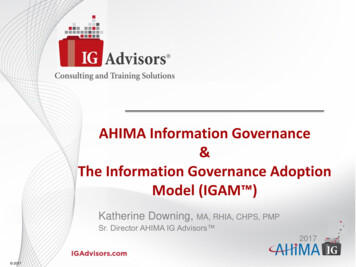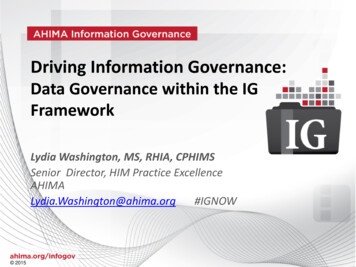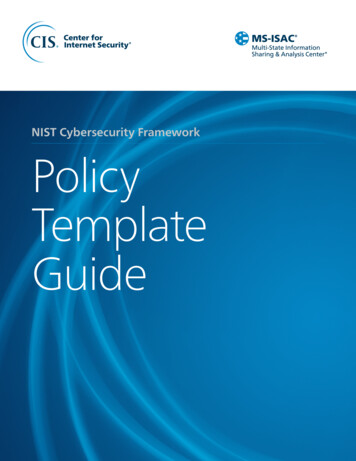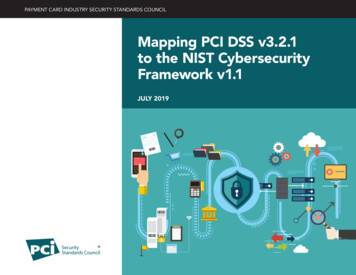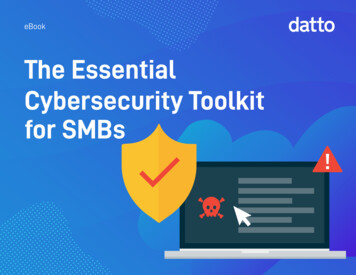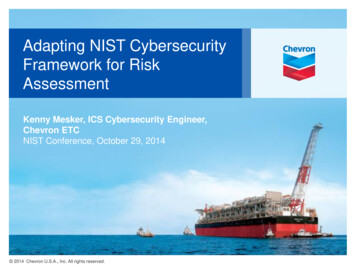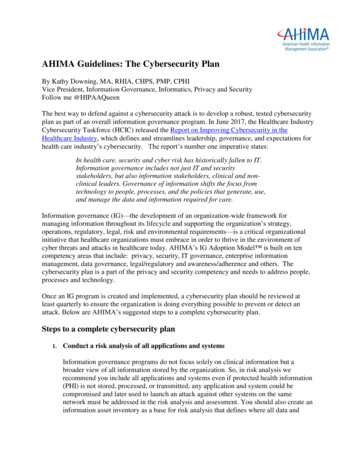
Transcription
AHIMA Guidelines: The Cybersecurity PlanBy Kathy Downing, MA, RHIA, CHPS, PMP, CPHIVice President, Information Governance, Informatics, Privacy and SecurityFollow me @HIPAAQueenThe best way to defend against a cybersecurity attack is to develop a robust, tested cybersecurityplan as part of an overall information governance program. In June 2017, the Healthcare IndustryCybersecurity Taskforce (HCIC) released the Report on Improving Cybersecurity in theHealthcare Industry, which defines and streamlines leadership, governance, and expectations forhealth care industry’s cybersecurity. The report’s number one imperative states:In health care, security and cyber risk has historically fallen to IT.Information governance includes not just IT and securitystakeholders, but also information stakeholders, clinical and nonclinical leaders. Governance of information shifts the focus fromtechnology to people, processes, and the policies that generate, use,and manage the data and information required for care.Information governance (IG)—the development of an organization-wide framework formanaging information throughout its lifecycle and supporting the organization’s strategy,operations, regulatory, legal, risk and environmental requirements—is a critical organizationalinitiative that healthcare organizations must embrace in order to thrive in the environment ofcyber threats and attacks in healthcare today. AHIMA’s IG Adoption Model is built on tencompetency areas that include: privacy, security, IT governance, enterprise informationmanagement, data governance, legal/regulatory and awareness/adherence and others. Thecybersecurity plan is a part of the privacy and security competency and needs to address people,processes and technology.Once an IG program is created and implemented, a cybersecurity plan should be reviewed atleast quarterly to ensure the organization is doing everything possible to prevent or detect anattack. Below are AHIMA’s suggested steps to a complete cybersecurity plan.Steps to a complete cybersecurity plan1.Conduct a risk analysis of all applications and systemsInformation governance programs do not focus solely on clinical information but abroader view of all information stored by the organization. So, in risk analysis werecommend you include all applications and systems even if protected health information(PHI) is not stored, processed, or transmitted; any application and system could becompromised and later used to launch an attack against other systems on the samenetwork must be addressed in the risk analysis and assessment. You should also create aninformation asset inventory as a base for risk analysis that defines where all data and
information are stored across the entire organization (again not justPHI). This should include biomedical devices, mobile devices andlegacy systems.2.Recognize record retention as a cybersecurity issueHealthcare organizations have been storing and maintaining records and information wellbeyond record retention requirements. This creates significant additional security risks assystems and records must be maintained, patched, backed up, and provisioned (access)for longer than necessary or required by law.Destroy records, emails, and documents per policy in compliance with state and federallaw. In the era of big data the idea of keeping “everything forever” must end. It simply isnot feasible, practical or economical to secure legacy and older systems forever.3.Patch vulnerable systemsWhen patches (updates) are released by the manufacturer of a system or software, theyshould be implemented immediately.4.Deploy advanced security endpoint solutions that provide more effective protectionsthan standard antivirus toolsPattern files alone are not effective. Endpoint security should include device and user IDbehavior monitoring, called User Behavior Analytics (UBA)5.Encrypt the following:ooo6.Workstations (high-risk) and laptopsSmartphones and tabletsPortable media and backup tapes (if tapes are still being used)Improve identity and access managementStrengthen password requirements. You can also apply password standards consistentlyin applications and systems, including biomedical devices. You might also choose to lockusers out of an application or systems after a predetermined number of failed log-inattempts. Implement two-factor authentication where feasible, especially for remoteaccess by system administrators. Restrict concurrent log-ins, as many workers only needto log in once. Disabling additional log-ins for the same user or ID can prevent that IDfrom being used inappropriately.Implement time-of-day restrictions. If a worker only uses a computer on their one workshift and doesn’t have remote access privileges, for example, applying time-of-dayrestrictions eliminates the possibility of that ID being used by someone else during a timewhen it should not be in use.
Finally, educate users, as part of the information governanceprogram, about their responsibilities for information creation,access, use, disclosure and destruction.7.Refine web filtering (blocking bad traffic)Block traffic to/from foreign countries you are not actively doing business with.Quarantine or block inbound e-mail traffic that comes from a newly created domain;most phishing attacks come from domains that have only been in existence for a fewdays. Force employees to use their personally owned mobile device through a “guest”wireless network for accessing their personal accounts; block employees from accessingpersonal sites.8.Implement Mobile Device Management (MDM)This strategy can help enforce security controls for tablets and smartphones (personallyowned or organization-owned devices).9.Develop incident response capabilityThink to yourself: “It’s not a matter of ‘if’—it’s a matter of ‘when.’” By creating incidentresponse playbooks, educating a response team and conducting a tabletop drill thatincludes common cyberattacks and/or system compromises can appropriately prepareyour team.10.Monitor audit logs to selected systemsConsider outsourcing this task to a Managed Security Service Provider (MMSP), anorganization that specializes in monitoring key systems for possible attacks.11.Leverage existing security tools like Intrusion Prevention System/IntrusionDetection System (IPS/IDS) to detect unauthorized activitiesMany organizations already have security tools available to them, but the tools have notbeen implemented or turned on (security flexibility within systems may not be activated).12.Evaluate business associatesObtain reasonable assurances of compliance with the HIPAA Security Rule from currentbusiness associates; start with companies that represent a high risk such as smallerorganizations. Also, evaluate the risks associated with any potential (new) businessassociate and prior to purchasing a product or service.13.Improve tools and conduct an internal phishing campaign
Stop employees from clicking on embedded links by teaching themwhat to look for, including:ooooooooooSuspicious e-mail URLsURLs that contain a misleading domain namePoor spelling and grammarAn e-mail that asks for personal informationThe offer seems too good to be trueYou did not initiate the actionYou are asked to send money to cover costsUnrealistic threatsMessage appears to be from a government agencySomething does not look right14. Hire an outside security firm to conduct technical and non-technical evaluationsThis might include conducting a vulnerability scan of external-facing systems, running apenetration test of key applications and systems and evaluating policies, procedures, andorganizational practices pertaining to the IT environment.15. Prepare a ‘State of the Union’ type presentation for an organization’s leaders oncybersecurityBe prepared to answer questions such as:oooooHow are we doing as compared to similar organizations of our size?Who is in charge of our cybersecurity program?What are we doing to reduce our risk of an attack?How and when will the board be notified if there is a cyber breach?Do we have cyber insurance?16. Apply a ‘Defense in Depth’ StrategyIn order to thwart an attempted intrusion by a cyber-attack, take a proactive stance in yourcybersecurity defenses. Review current access control protocols and tighten them up, ifindicated. Another proactive step you can take is to conduct an evaluation or assessment ofcurrent security policies. If they have not been updated or modified to account for risks ofhacking, this is an action item that should be undertaken.Reactive measures should also be taken to optimize your cybersecurity strategy. A review ofaudit logs on a regular basis is strongly recommended. Review the organization’s incidentresponse capabilities and update the incident response plan. This holds true also for anorganization’s disaster recovery plan and data backup plan. Conducting a desktop drill (orseveral) periodically will help to minimize missteps in the case of cybercriminal intrusion.
17. Detecting and Preventing IntrusionIntrusion detection systems (IDS) are designed to detect and identifya potential intruder by monitoring network and/or system activities to spot maliciousactivities by signature-based or anomaly detection methods as well as other protocolbased procedures. IDS can produce reports and identify trends that could be indicative ofcyber-type issues taking place.Intrusion detection and prevention systems (IPS or IDPS) allow prevention capabilities tobe set by the administrator. This feature allows the organization to determine the tuningand customization settings that are preferred so that thresholds and alerts are at the levelof tolerance for the organization. Once these settings are established, they should bereviewed and adjusted to allow for appropriate detection and, ideally, blocking.Every organization must identify their level of need for intrusion detection andprevention. Given the rise of cybercriminal activity aimed directly at healthcare, this is asubject that should be addressed for its relevancy with a sense of urgency to ensure thatthe entire health system’s PHI, in every system, is adequately protected to the best extentpossible.Glossary of Security Terms to Know:Breach: An incident in which sensitive, protected, or confidential information has potentiallybeen viewed, stolen, or used by an individual unauthorized to do so.Ransomware: A type of malware that prevents or limits users from accessing their system. Thistype of malware forces its victims to pay the ransom through certain online payment methods inorder to grant access to their systems, or to get their data back. Some ransomware encrypts files(often called Cryptolocker).Phishing: The attempt to acquire sensitive information such as usernames, passwords, and creditcard details (and sometimes, indirectly, money), often for malicious reasons, by masquerading asa trustworthy entity in an electronic communication.Hacktivist: A computer hacker whose activity is aimed at promoting a social or political cause.Malvertisements: The use of online advertising to spread malware. Malvertising involvesinjecting malicious or malware-laden advertisements into legitimate online advertising networksand webpages.Cloud Storage: A model of data storage in which the digital data is stored in logical pools, thephysical storage spans multiple servers (and often locations), and the physical environment istypically owned and managed by a hosting company.
References:Anand, Priya. “How Long Does It Take To Hack a Company? Just Minutes, Report Says.”MarketWatch. April 14, 2015. .Ferrillo, Paul A. “Wham, Bam, Thank You Spam! Don’t Click on the Link!” Harvard LawSchool Forum on Corporate Governance and Financial Regulation. May 17, nt. “Beyond the Breach.” 2014. each.htmlThis material includes excerpts from:Dill, Mark W., Susan Lucci, and Tom Walsh. "Understanding Cybersecurity: A Primer for HIMProfessionals" Journal of AHIMA 87, no.4 (April 2016): 46-51 [extended web version].http://bok.ahima.org/doc?oid 301408.US Department of Health and Human Services, Healthcare Industry Cybersecurity Taskforce.“Report on Improving Cybersecurity in the Health Care Industry.” June erTF/Pages/default.aspx
Information governance includes not just IT and security stakeholders, but also information stakeholders, clinical and non- clinical leaders. Governance of information shifts the focus from technology to people, processes, and the policies that generate, use, and manage the

